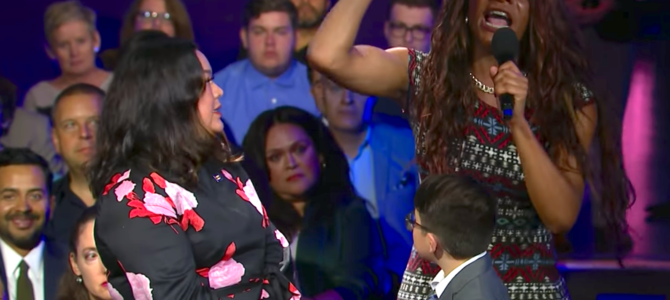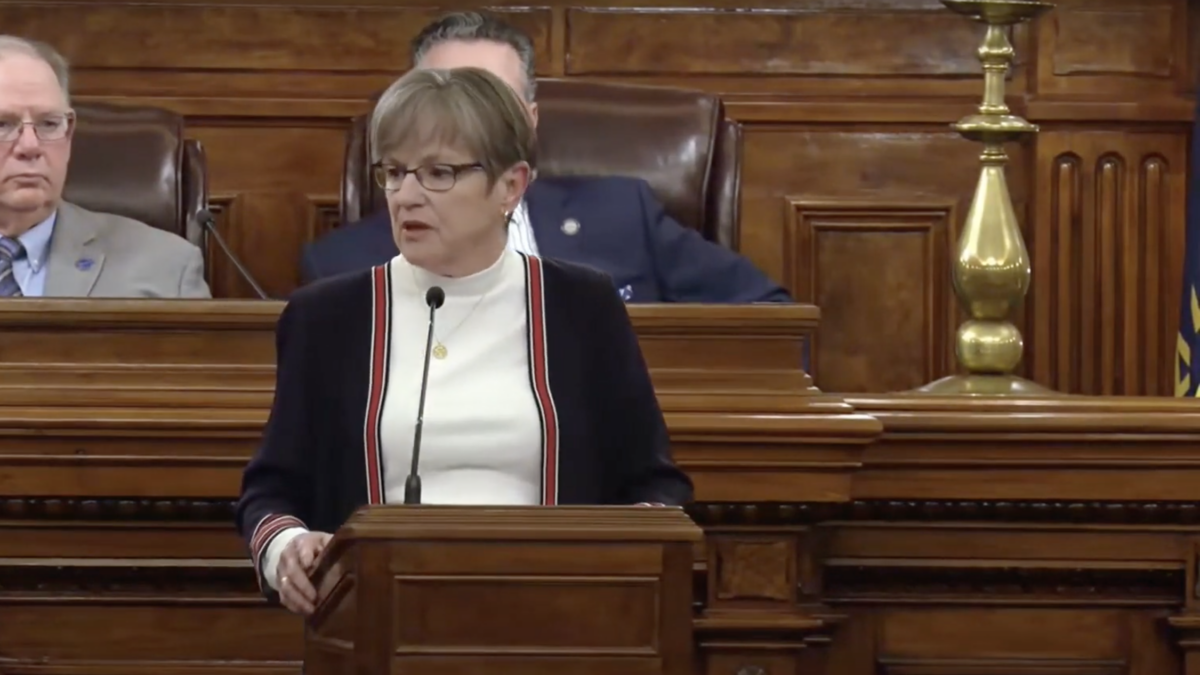
“Trans people are dying!” chanted a group of transgender protesters interrupting Democratic presidential candidate Pete Buttigieg during one of many CNN discussions on LGBT issues. Beto O’Rouke and Don Lemon were greeted by a passionate trans activist named Blossom Brown, who shouted, “Black trans woman are being killed in this country, and you have erased trans women for the last time.”
Kamala Harris responded compassionately to an audience member who interrupted her forum by shouting, “How do we get those men to stop killing us? How do we get those men to stop killing trans women of color? We are hunted. Systematically hunted. How can they do that?”
In response to these accusations, Buttigieg calmly assured the audience, “I would like to believe everyone here is committed to ending that epidemic.” Harris responded to the question of how she would address violence against transgender people by saying, “There has to be serious consequence and accountability when it happens.”
Sen. Cory Booker took the issue a step further when addressing more widespread accusations of anti-LGBT violence, referring to it as a national emergency and saying, “We live in a country where we still see regular, everyday violence and intimidation and bullying against Americans because of who they are.” He proposed an “Office of Hate Crimes and White Supremacy” to handle the issue.
The media alarm bells have been resonating on this topic for quite a while, and as each year passes, the ritual listing of transgender murder victims has become a staple of LGBT reporting. In fact, it is impossible to find any article detailing a particular murder without a paragraph or two devoted to discussing the “epidemic” of violence against transgender males dressing as females, specifically of color. It is clearly embedded in our collective consciousness despite the right’s efforts to shed light onto the issue with far more accurate and rational reporting.
Does the Data Show an ‘Epidemic’ of Hate?
I have spent much writing discussing how these stories are exploited and manipulated to create an impression of violence and hatred that rarely reflects reality. As such, I have become familiar with nearly all of the cases so often repeated, but I realized it was time to collect them together and analyze them as a whole.
The Human Rights Campaign has organized this information in packets starting in 2015 through the present. Using these resources, I independently researched each case to the best of my ability with the available information. The HRC reports can be found here: 2015, 2016, 2017, 2018, 2019.
In the HRC’s 2019 ongoing information page, the organization made this important statement:
Some of these cases involve clear anti-transgender bias. In others, the victim’s transgender status may have put them at risk in other ways, such as forcing them into unemployment, poverty, homelessness and/or survival sex work.
After years of simply declaring “hate” to be the core motivation, this comes as a refreshing admission of the realities surrounding these murders. However, the LGBT left’s bias toward victimhood still pushes them to place blame where no feasible solution could be found to resolve it.
Table 1: Known Murderers from 2015 to 2019

Of the 118 listed cases from 2015 to 2019, 52 have known murderers. The above chart reveals that the racial identity of the victim and the murderer seem entirely irrelevant to the murder motivation.
While 67 percent of the victims are indeed black, and the majority are trans women, as reported, the majority of their killers are black as well. This is true for white victims and a single Native American victim who was murdered by a Native American killer. In the 2016 case of Brandi Bledsoe, the murderers were both black and white and were also trans women.
Causes of Death Among Transgender Victims
Table 2: Cause of Death

The two largest known categories of murders occur as a result of domestic violence and prostitution. Domestic violence is a known concern in the LGBT community, with a Williams Institute 2015 study finding 25 percent of gay men and 40 percent of lesbian women reporting intimate partner violence.
In prostitution, or “survival sex,” at least 80 percent of sex workers report violence. In my study, I included all personal relationships reported by the press surrounding known cases. Domestic violence does not always target the trans partner, as in the 2017 case of Kashmire Nazier Redd, who physically assaulted Redd’s girlfriend, who defended herself with deadly force and was found not guilty of the crime.
Personal disputes resulting in violence often involve drugs, as the 2017 killing of Stephanie Montez demonstrates, wherein the victim sold drugs to a friend who murdered Montez over a $20 dispute. Gang involvement is another violent motivator, as in the 2015 cases of Mercedes Williamson and Elisha Walker, both murdered by their boyfriends after threats from the Latin Kings caused them to fear for their safety. In 2019, Claire Legato was murdered while intervening in a violent dispute between Legato’s mother and John Booth, a friend, over a tax refund check.
Unfortunately, nearly 30 percent of cases have no information, suspects, or motives to determine a cause of death. The HRC reconciles this information, stating, “While the details of these cases differ, it is clear that fatal violence disproportionately affects transgender women of color, and that the intersections of racism, sexism, homophobia, biphobia, transphobia and unchecked access to guns conspire to deprive them of employment, housing, healthcare and other necessities, barriers that make them vulnerable.” But there is no clear understanding of what could be done to prevent these proposed underlying causes when the violence is significantly personal or environment-based.
What Really Happened in These Transgender Murders?
Several included cases make no sense with regard to the purpose of the awareness campaign. For example, five cases involved the police responding to violent scenarios in which the transgender person, mostly trans men (meaning women who identify as men), attacked police officers.
A trans man named Jordan Cofer was one of 20 victims in a 2019 mass shooting in Dayton, Ohio. Nikki Enriquez was murdered in 2018 by Juan David Ortiz, a Border Patrol supervisor and serial killer who targeted sex workers. In the 2016 case of Demarkis Stansberry, a trans man, Stansberry’s friend accidentally shot Stansberry on New Year’s Eve.
After reviewing the 118 cases with all available information, four appear to have been directly anti-trans-motivated. In 2016, Kedarie Johnson, a gender-fluid 16-year-old from Des Moines, Iowa, was picked up by two men, Jaron Purham and Jorge Sanders-Galvez. He was dressed as a woman, and the two men intended to have sex with him. They murdered him once they discovered he was male. Both received life in prison.
Also in 2016, Dee Whigham, a 25-year-old transgender woman from Hattiesburg, Mississippi, met Dwanya Hickerson, 21, with whom Whigham had an online relationship. Once Hickerson discovered Whigham was transgender, he stabbed Whigham 119 times. Hickerson has been sentenced to 40 years in prison.
An attempted serial killer named Denzell Thomas, 24, targeted trans women in Birmingham, Alabama, and murdered Jazz Alford, a 30-year-old trans woman. He also shot another trans woman who survived. He was sentenced to 25 years in prison.
In 2019, Devon Robinson, 18, in Detroit, Michigan, shot five people at a house party, including two gay men and one trans woman, Paris Cameron, 20. In his trial, he stated he shot multiple people while attempting to target LGBT individuals.
We Need Honesty About Crimes Against Trans People
Although LGBT advocates and media insist these cases do not represent a true picture of violence, as often the victim is identified as a different sex by the police until family or friends correct reports, we still have no evidence of a pattern or “epidemic” of violence. It is certainly false that trans women are being “systematically hunted” or that black trans women are specifically targeted.
What we do know from all available resources is that the violence these individuals experience occurs to a very broad range of people with diverse backgrounds and identities. It is clearly more an issue of high-risk environments than identity-based discrimination.
Another important element to recognize is that regardless of gender identity, local, state, and federal authorities take each case very seriously, and more than half of reported crimes have resolved in sentencing. No one is looking the other way or tolerating this violence, and certainly not because the victims are transgender.
The truth is there is very little our government or society could do to reduce these incidents. They result from cultural influences, dangerous environments, and high-risk engagements. The most powerful effects the left, LGBT advocacy and media, and Democratic leaders could have in protecting transgender people would be to tell the truth about prostitution, drugs, risky sex practices, and domestic violence. Continuing the narrative of fighting hatred and bigotry will do nothing more than win popularity points; it won’t save lives.









